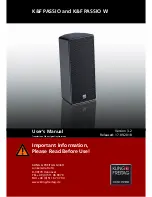
Transmitter Functional Blocks
Chapter 9 - Theory of Operation
•
transducers and operating modes
•
fetal movement detection bit
•
battery status
•
external marker information
•
Nurse call button
•
INOP condition of ECG
•
CRC (checksum over one frame)
•
Special transmitter ID after power up (Japan only)
Oscillator
This circuitry produces the different clocks needed in the Transmitter. The
oscillator is crystal controlled and starts operation at power supply voltages as
low as 2V. This is necessary because the oscillator also drives the power
supply. To ensure a start up over the complete specified battery voltage range,
the oscillator must start at this low voltage. The clock freqencies are:
•
2 MHz for the mircocontroller
•
1 MHz for the ultrasound drive/receive clocks and the power supply.
•
500 kHz for the Toco sigma-delta A/D converter.
•
250 kHz for the ECG driver and the Toco sigma-delta A/D converter.
Power Supply
The power supply is a switched mode power supply with step up operation.
It works with a 250 kHz clock frequency (delivered by the oscillator) in a
pulse width modulation mode. It is capable of delivering the necessary power
in a fixed 5V output voltage for input voltages between 2.5V and 4.7V. (This
covers the input voltages delivered by three AA type alkaline batteries or three
AA type NiCd/NiHd accumulators).
Other supply voltages are derived from the 5V supply by linear regulators or
by charge pumps runing at 250 kHz.
•
2.5V as virtual ground (linear regulator)
•
8.5V for ultrasound preamplifier and OP-Amps (charge pump as
voltage doubler.)
•
-3.5V for OP-Amps (charge pumps as voltage inverter).
Service Interface
The service and production interface uses the marker input as the I/O
connector for settings and internal status readings for service and production
tests.
It is a RS232 similiar (0.5V only levels) serial interface with a specific
protocol. This interface is used for:
•
setting the Transmitter's serial number
•
reading some internal values for prodution tests
•
writing correction factors for the Toco frontend into the EEPROM.
Содержание 50 T Series
Страница 4: ......
Страница 10: ...x List of Figures ...
Страница 26: ...Error Messages Chapter 3 Tests and Error Messages ...
Страница 35: ...Cardio Channel Chapter 4 Troubleshooting Cardio Channel Figure 7 Troubleshooting Cardio Channel ...
Страница 36: ...TOCO Channel Chapter 4 Troubleshooting TOCO Channel Figure 8 Troubleshooting TOCO Channel ...
Страница 39: ...Event Marker Chapter 4 Troubleshooting Event Marker Figure 11 Troubleshooting Event Marker ...
Страница 40: ...Nurse Call Chapter 4 Troubleshooting Nurse Call Figure 12 Troubleshooting Nurse Call ...
Страница 42: ... Chapter 5 Interfacing to a Fetal Monitor ...
Страница 48: ...Using the Service Program Chapter 6 Using the Service Software ...
Страница 51: ...Lists of Parts Chapter 7 Replacing Parts Figure 14 Transmitter Parts ...
Страница 53: ...Lists of Parts Chapter 7 Replacing Parts Figure 15 Receiver Boards ...
Страница 78: ...Receiver VCXO Test Chapter 8 RF Bench Repair ...
Страница 102: ...USA Chapter 11 Channels and Frequencies ...
















































